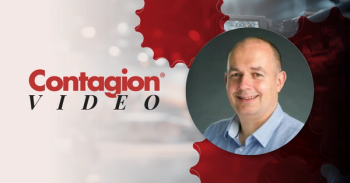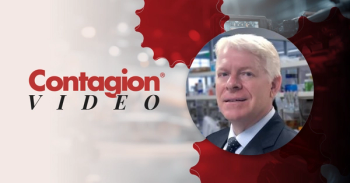
Reviewing the Pharmacology and Biochemistry of Remdesivir for COVID
Sarah Jorgensen, PharmD, MPH, BCPS, BCIDP, AAHIVP, provides a deep dive on the pharmacology and biochemistry of remdesivir.
Segment Description: Sarah Jorgensen, PharmD, MPH, BCPS, BCIDP, AAHIVP, provides a deep dive on the pharmacology and biochemistry of remdesivir.
Interview transcript (modified slightly for readability):
Contagion®: Hi, I’m Allie Ward, editorial director of Contagion®. Joining me today is Dr. Sarah Jorgensen, an antimicrobial stewardship pharmacist with Sinai Health System in Toronto. Dr. Jorgensen, thanks so much for taking the time to speak with Contagion® today. What was your day-to-day like prior to COVID and what is it like now in the middle of the pandemic?
Sarah Jorgensen, PharmD, MPH, BCPS, BCIDP, AAHIVP: Like most people working in hospitals, everything has sort of shifted focus to preparing for and then dealing with COVID. Like most people, Zoom calls and meetings have become part of my daily routine. I'm unfortunately still that person that talks for 5 minutes with a muted microphone, so hopefully I'll get the proper Zoom etiquette before this is all over.
Contagion®: You recently authored a
Jorgensen: Yes, it's a really kind of neat molecule. It's called a monophosphoramidate nucleoside analogue prodrug. What it does is it competes with our endogenous nucleotides to get incorporated into the viral RNA. It was originally developed in response to the Ebola outbreak back in 2014, but was found to have really good activity, at least in vitro, against a broad range of coronaviruses, including SARS-CoV-2. For nucleotide analogues to be active, they have to get triphosphoralated, so that's adding 3 phosphate groups and adding that first phosphate group is what really slows things down. Remdesivir actually has a phosphoramidate group, which is sort of like a mask phosphate group, so that it hides until it penetrates into the cell, and then it gets unmasked and can quickly add those 2 more phosphate groups so it kind of has a jumpstart on being active and then it's good to go.
Another thing with nucleotide analogues against coronaviruses in general is that they've really been hindered by a viral enzyme called [exoribonuclease]…This enzyme goes along and it proofreads the growing RNA chain and takes out errors, which includes those analogues and so remdesivir is actually partly able to evade this enzyme. It does this through 2 mechanisms. First, it gets incorporated into the RNA chain really quickly, actually more efficiently than even our own endogenous nucleotides. And then the other reason is, when it does get incorporated, 3 more of our endogenous nucleotides get incorporated after it, and those serve to protect it from the from the enzyme that wants to splice it out. That's why we think, at least in vitro, that it seems to be pretty potent and evade a lot of these things that have hindered previous nucleoside analogues.
Contagion®: What about safety concerns?
Jorgensen: I think we're learning about that really quickly. In the phase 1 studies and in also some of the Ebola studies and then [with] the compassionate use…One thing that we saw kind of consistently were these elevations in transaminase enzymes even in healthy volunteers, but it doesn't seem to have panned out in the 2 [randomized controlled trials RCTs] that that we've seen so far. They were underpowered really to detect serious liver abnormalities, but that has been reassuring that we're not seeing major problems at least so far with that regard.
Contagion®: Are there any concerns of resistance?
Jorgensen: That's still an open book. It has been found to occur in in vitro studies, but we still don't really have anything in humans yet. I think we know from chronic viral infections that we tend to need cocktails of drugs to prevent resistance development. This is really the first drug that has shown any meaningful benefit for an acute viral pneumonia, so it's really unknown territory in terms of how we need to be using these [and] whether it's okay to do monotherapy or combination therapy [and] how quickly resistance can develop.
Contagion®: Are you encouraged by some of the
Jorgensen: Before the ACTT-1 study, the data was really hard to interpret. We had that compassionate use report in New England Journal, the 61 patients but no control arm. And then the study in China by Wang and colleagues came out but had to stop early so it didn't reach its target enrollment and kind of left us with inconclusive results. So it was great to see the ACTT study finally come out. I think this was a really solid study. To enroll over 1000 patients from I think it was 60 sites globally in just a couple of months in the middle of a pandemic is really a pretty tremendous accomplishment. As I said before, this is the first time that we've actually seen a drug provide meaningful benefit for viral pneumonia. The odds were kind of stacked against it to start with. That said, , the benefit was pretty modest and the outcome, although it does seem very objective, there is still some subjectivity in deciding on oxygenation and when to discharge patients.
It was really a shame that it was stopped early. They had enrolled all of the patients, and a couple more weeks and we would have perhaps had more conclusive results around the mortality. I think at this point, we see that it hastens time to recovery. But without the full data, we don't know if it is helping patients recover who wouldn't have otherwise recovered or if it is just accelerating time to recovery in those who really would have anyway, which is valuable, especially in overstretched health care systems, but it would have been really nice to have the full results be able to be analyzed.
This is one study, too. I think to really be more sure about its efficacy, we do need to see it replicated, but fortunately there're many other RCTs still going on, so [I’m] looking forward to those and also the second arm of the ACTT study adding baricitinib.
That should be really interesting to see how that plays out because we know that in more severe patients, it seems like it's more of the hyperimmune response that is underlying a lot of the acute organ failure that we're seeing so maybe adding one of those on could provide some benefit. Although it's still a tricky balance because exactly when to add it and not cause problems with hindering viral clearances and stuff, too.
Contagion®: What is the most important thing you think clinicians need to know about this drug?
Jorgensen: I think knowing that, at this point, it doesn't seem to be a panacea for the illness, especially since we didn't see a huge benefit in those most severely ill patients, so we don't know if this is just because those groups were smaller or if [we] need something more powerful or different mechanism at that point.
I think being really vigilant and monitoring for any safety signals…[there are] still not a whole lot of patients that have been exposed to it yet so that's still kind of an evolving field.
Contagion®: Your work focuses on antimicrobial stewardship. What sort opportunities to practice stewardship have you observed in this climate of COVID?
Jorgensen: It’s really been information-gathering and providing education. There's just a ton of data and studies coming out all the time and preprints have kind of waded into the forefront for the first time so it's really fishing through that and picking out what can help inform practice and what's good science.
In terms of stewardship, I think it has been kind of tough because when patients present with acute respiratory infection, you don't know at the time whether it's bacterial or viral. And so a lot of patients still are getting empiric antibiotics and it's knowing when and if you can peel those off.
The whole patient population for us has kind of changed too, because a lot of elective procedures have been postponed. We see a lot of usually chemo patients, so some of their treatment has been postponed too so infections in those patients are not as prevalent, but we're, of course, picking up instead a lot of COVID patients.
Contagion®: Is there anything else that you would like to add?
Jorgensen: Just to stay tuned for what's coming up and I think there's a lot of exciting work going on and just the speed of the randomized controlled trials they're getting up is pretty amazing. So that should be exciting. I know that we're starting up several at our hospital as well so it'll be interesting to see how those play out too.
Newsletter
Stay ahead of emerging infectious disease threats with expert insights and breaking research. Subscribe now to get updates delivered straight to your inbox.

































































































































































































































































































